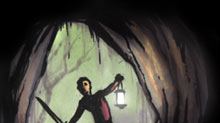by Demian Katz
 Witchfire Trilogy, Part One: The Longest Night
Witchfire Trilogy, Part One: The Longest Night
Written by Matt Staroscik
Published by Privateer Press
64 b & w pages
$9.95
The majority of role-playing supplements tend to fall into one of two categories:
ready-to-run adventures for the busy GM, and collections of inspirational
background material for the do-it-yourselfer. I tend to prefer the former,
though many others swear by the latter. Whichever your preference, though,
you've probably noticed that the two supplement types rarely overlap effectively.
When a ready-to-run adventure includes details of historical battles or local
government, it's more likely to consist of a bunch of hard-to-pronounce names
than it is to be something that could inspire entire sub-quests. Similarly, when
a sourcebook on a particular species or region or whatever includes
adventure-related material, it's more likely to be a collection of half-hearted
seeds or a brief and uninspired encounter description than it is to be something
you would actually want to use.
With The Longest Night, Privateer Press has made great strides in joining
the ready-to-run adventure and the sourcebook into a single tool that anyone
could enjoy and find useful. The book serves two complementary purposes: it sets
up the overall storyline of the Witchfire Trilogy (which, logically enough,
consists of this and two other modules), and it introduces a new and intriguing
campaign setting.
The adventure starts with the players getting sucked into the
investigation of a series of grave robberies and eventually discovering a plot
for revenge relating to nasty events of a decade earlier. The plot is nicely
layered, with villains manipulating villains and NPCs driven by complex
motivations. Most of these details will not be revealed until later in the
trilogy, but it is clear from the start that players experiencing these
adventures will be treated to some genuinely interesting twists and turns.
The book concentrates mainly on introducing key locations and concepts by
leading the party from location to location in episodic fashion. Sidebars are
provided throughout to detail the history and workings of the Iron Kingdoms
setting in which the adventure takes place, and these prove valuable both for
adding flavor and for seeding side-quests. Although it's possible to play
straight through the adventure concentrating solely on the main plot, it's also
easy to insert numerous distractions in order to make it into a more
long-term, epic campaign.
Normally my inclination would be to take the "play straight through" approach --
as I'm sure I've said before, I tend to be a lazy GM. However, there's something
about this book that captures my imagination and inspires me to work for extra
mileage. It's not that the Iron Kingdoms are an especially original setting; the
one-line summary could be "generic fantasy with steam power and guns." Still,
while the overall world doesn't redefine any genre conventions, the city of
Corvis, which serves as the player characters' base of operations, makes use of
all the atmospheric elements that make for an exciting role-playing experience.
The so-called "City of Ghosts" is surrounded by a swampy wood so horrible that
anyone who dies alone in it returns to life and seeks revenge on anyone who left
her there. The city also happens to be so old that its original structures have
sunken into the swamp and been rebuilt upon, resulting in a maze of underground
passageways which are an irresistable temptation for dungeon crawlers. Add in
some organized crime, a weird and amusing race of humanoids that like to ambush
travelers, and ruins left behind by an ancient empire, and you've got everything
you need for a few months' worth of fun.
While providing broad ideas that can be fleshed out into
extra gaming sessions, the book also delivers details that a GM needs to run a
convincing game. The aforementioned sidebars are extremely valuable, but they're
not the only tools provided. There's also a set of appendices containing some
believable and well-described monsters, detailed NPC backgrounds and, to help
with improvisation, a set of NPC foundations which can be used to generate thugs,
merchants and watchmen on the fly. I was really thrilled by the way crucial
NPC conversations are handled. In most adventures, segments like these tend to
be very densely packed with information, generally requiring the GM to memorize
it all since there's otherwise little hope of finding a particular detail when
questioned. In this adventure, however, the conversations are laid out in a
point-by-point fashion, making it easy to find key details without in any way
hampering the GM's ability to embroider and improvise.
The book's layout nicely complements its excellent content, effectively balancing
style with functionality. The font is distinctive but readable, the
illustrations, though largely unexceptional, are appropriate and relatively
unobtrusive, and the maps are professional-looking if occasionally a little
unclear. Even the unclear maps pose only a minor inconvenience.
There are really only two other things worth complaining about.
First, several room descriptions repeat the boxed text in unboxed form as
part of the description, a mistake that should probably have been caught during
copy editing. More seriously, the subject matter of the cover art reveals more
of the plot than I think it should. GMs wishing to keep things surprising will
probably want to cover it up somehow and simultaneously pray that their players
don't browse store shelves too attentively.
Still, these are at most minor inconveniences in an otherwise exceptional
product. Perhaps the best news of all is the price tag: $9.95 is really quite
reasonable for 64 perfect-bound pages of genuinely useful material. When you
consider the useless filler that some competitors offer for even higher amounts,
the meaty content of The Longest Night practically begs to be owned by any
GM who enjoys a great, high-quality adventure.




